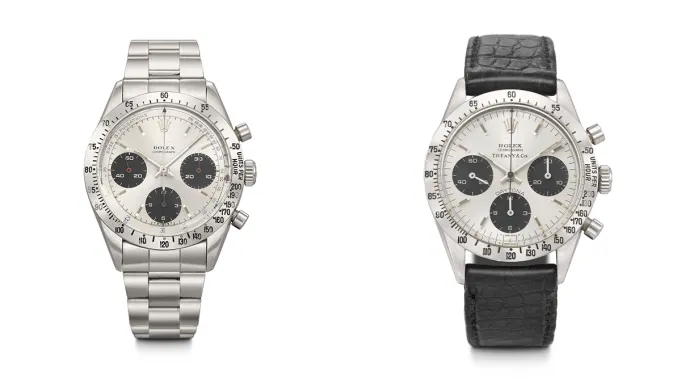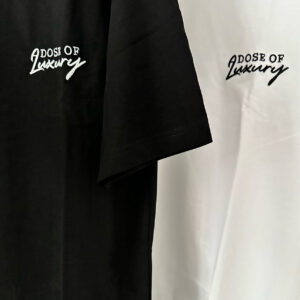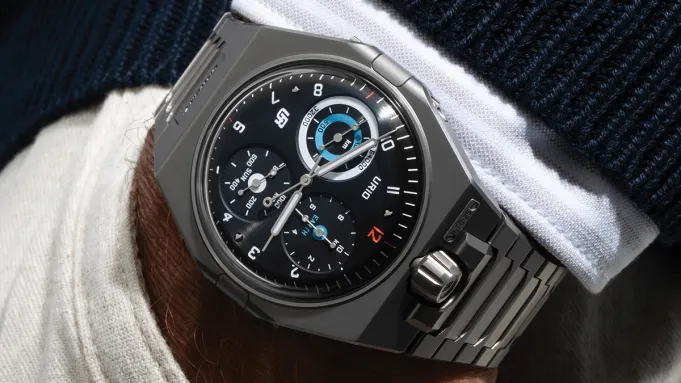
Not all Rolex Daytonas are created equal. Some, like the two headlining Christie’s upcoming Rare Watches auction in Geneva, have wonderful horological anomalies that set them apart from more run-of-the-mill references.
The two highly desirable vintage timepieces will go under the gavel for the first time since they were made in 1967 and 1970, respectively. Each is expected to hammer down for six figures, with the high pre-sale estimates reflecting their incredible pedigree and provenance.
The first Daytona up for grabs is a Reference 6239 from 1967. Produced in stainless steel and gold from 1963 to ‘69, Ref. 6239 was the Crown’s first chronograph to have the tachymetre scale engraved on the bezel and subsidiary dials printed in a contrasting colour for greater legibility. The early models only featured “Cosmograph” on the dial and not the “Daytona” name. (That designation came later in 1964.)

Rolex Daytona Ref. 6239, a.k.a. “the Doctor,” made circa 1967.
Christie’s
Nicknamed “the Doctor,” this particular reference showcases the distinctive pulsations dial created for doctors to take a patient’s pulse. The silvered soleil face shows black subsidiary dials and an outer bright blue pulsations scale calibrated for 15 pulsations.
Fittingly, this example is being offered by a Florentine doctor and is in “superb condition,” according to Christie’s. Furthermore, the auction house says it is one of the scarcest variants of reference 6239 and a standout of the entire Cosmograph family. Only a handful of such models have surfaced over the years, with probably fewer than five examples existing today. It is expected to sell for between $510,000 and $760,000.

Rolex Daytona Ref. 6262, retailed by Tiffany & Co., made circa 1970.
Christie’s
The second Daytona is a steel Reference 6262 from 1970 that features the signatures of both Rolex and Tiffany & Co. With a very short two-year production run spanning 1970 to ‘72, Ref. 6262 remains one of the scarcest and most coveted of the “pump-pusher” Daytonas. (They are equipped with the traditional, pump-style pushers that the Crown used before introducing screw-down pushers in 1965 with Ref. 6240.)
Rarer still are the double-signed versions of the 6262, with fewer than five examples bearing the Tiffany and Rolex signatures, according to Christie’s. What makes this one even more special is the fact that it has ties to the late, great George Peppard. The American actor, famous for his performances in Breakfast at Tiffany’s and The A-Team, purchased the double-signed beauty from Tiffany’s in Beverley Hills in 1972, giving it to his son, Brad, for Christmas that year. The caseback is engraved with “Brad Peppard December 1972 Love Dad,” in fact.
“When I think of my father, I always imagine him wearing his Rolex. It was simply a part of him,” Peppard said in a statement. “So you can well imagine my delight, my amazement, when Christmas of 1972 I found exactly the same watch he loved, waiting for me under the Christmas tree. It was an unforgettable moment.”
Remaining with Peppard for the past half-century, the 6262 is expected to fetch between $130,000 and $250,000 at the auction.
“I have treasured this watch for over 50 years and it is not easy for me to say goodbye to this piece of my history, of my link to my father,” Peppard adds. “I hope that it will find a home with someone who will understand and appreciate all that it represents.”
The Rare Watches live auction will take place at the Four Seasons Hotel des Bergues on 10 November.
Authors
-

Rachel Cormack
Digital Editor
Rachel Cormack is a digital editor at Robb Report. She cut her teeth writing for HuffPost, Concrete Playground, and several other online publications in Australia, before moving to New York at the…
instagram:
Error: No feed with the ID 1 found.
Please go to the Instagram Feed settings page to create a feed.









